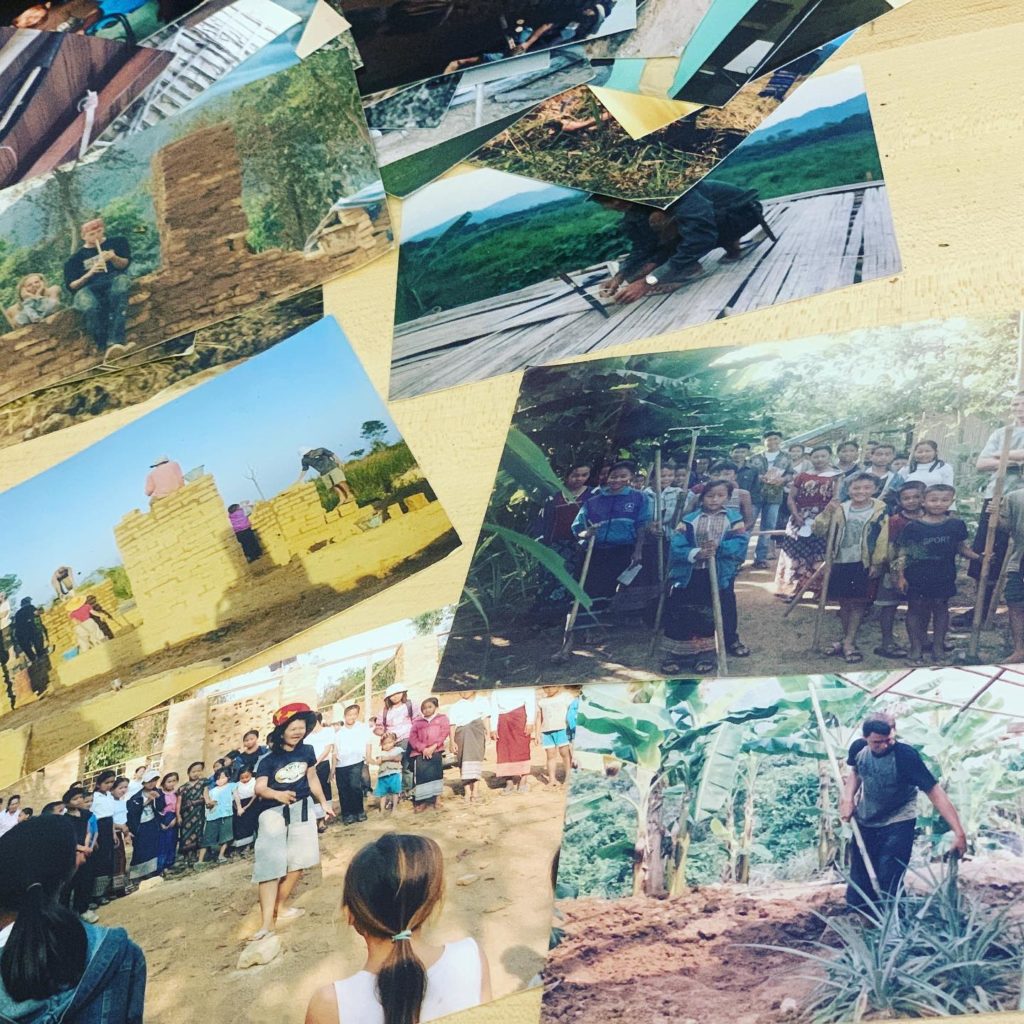Inspired by the melody that occurs at the intersections of the natural world, community and the built environment, The Natural Builders was founded and operates out of a commitment to pushing the limits of what social and environmental responsibility can mean. Since 2002 we have have grown a community of clients, mentors, staff and volunteer’s all with a common thread, people who genuinely wanted to leave a positive impact on the planet. What follows a sampling of those projects. It’s said that “Natural buildings can survive anywhere, all you need is a Good pair of boots and a good hat” meaning a good foundation and properly designed roof. My name is Kevin Rowell, I have been addicted to building community and with nature since a young age, below is a little background on how the Natural Builders and Naturalbuilding.com came into being.
Back Story
In the summer of 2002, I was volunteering with villagers in Thailand, displaced by the construction of a hydroelectric dam. Their valley was flooded and they fought for years to secure new land from the government. The land had come and with it the chance to build their new dream. a modern sustainable Earthen village named Man Yuen. The village would be built through dozens of workshops on the land over the coming months. It was a magical poetry of materials, community organization and the built environment. In a few months hundreds of volunteers helped build a community center and over a dozen homes, dug ponds, planted crops and traded culture and knowledge.
That was how I started working with a recently created organization called Kleiwerks International, and continued to work with them in dozens of projects around the world for the next decade, Kleiwerks and The Natural Builders would come to grow together in those early years. Kleiwerks International was founded as a US based non-profit committed to the continuation and evolution of Natural Building a Permaculture traditions. The project “Mun Yuen” was written about by Brendon Conley and later published in the book, “Building without Borders” Joseph F. Kennedy, 2004 published by New Society Press.
These early workshops in Thailand were so well attended that in the coming years, the revival of natural building would travel across Asia with dozens of education centers, communities, and throughout the built environment. A trend that has continued 20 years on, with modern structures popping up each year.
A few months of this work and I decided it was time for a little vacation in to Northern Laos. Of course not wanting to actually sit still I found the perfect spot through Willing Workers On Organic Farms “Woof” an International network of farms that welcomed short term volunteers. Phoudindaeng organic farm offered a warm welcome, the farms owner made us tea and showed me around all day. To my surprise, in the afternoon he pulled out a Thai Newspapers with articles about our projects in Thailand. He wasted no time asking for help creating projects to bring the Phoudindaeng community together.
At the time village, Ban Phoudindaeng had more recently become a resettlement site and home to 3 distinct ethnic groups Lao nationals, Hmong and Kamu. The latter 2 had been internally displaced by social and political conflict. Settling in Phoudindaeng created new opportunities but also brought complications. The owners of the local Organic farm, Mr.Thanongsi (also known as Mr.Tea) and his wife Peng Wan Soloungkoun wanted to assure social cohesion for their community despite cultural and language differences. They wanted to cultivate a “Kwam Samakee” which can best be described as a spirit of community and collaboration. To help with this he and the other elders wanted to explore natural building as a way to provide a community center. But before we could tackle a full community project we knew we needed to build a small example.
We started with a small house on the farm as a way to warm up the project, establish local relationship and get a feel for working together. I spent my time working on the house with and traveling between projects in Laos, Thailand and Cambodia.
The house itself was made through a combination of traveling international volunteers and local tradespeople. A rock and rubble foundation, adobe earthen walls, bamboo and local timbers formed the roof, mezzanine, door and counter.
We harvested lime and Grog (Fired Clay) from local kilns to add to plasters and used the blood of recently slaughtered animals as hardeners in the floor. Each person who helped on the project brought curiosity and insights, the whole community began to see the benefit of having this alternate form of tourism. One that allowed a closer participation from visitors.
Almost daily were Mr.T’s sharing of stories from the war. He had worked with the ministry of Agriculture, trained in Bulgaria, he came back during the war to help feed his country. He shared about the napalm burning the rice fields, and whole villages hiding in caves. As the agriculture ministry they came up with campaigns, like catchy songs that would travel like whispers on the wind. One spoke about the importance of planting the stalks of cassava all along the forest paths whenever you harvest some.
Even in my days in the tension between the Hmong and Laotian government were incredibly tense. Harking back to the war when Hmong villagers sided with he CIA and Us Military, helping US forces identify valuable targets. In early February 2003 a bus of 10 Laotion nationals and 2 Canadian bicyclists were gunned down in what was claimed to be a Hmong attack.

It wasn’t until nearly a decade later that I would come to understand the importance of the work in the village. Though some of the buildings themselves became abandoned others continued to thrive. Computers had been donated to the Youth Center and some of the youth from my time there were older now and running the programs. Quickly I was linked with dozens of friends from the village on social media, some had married or left the village, or country but we all remembered that time together and the lessons we shared.
You can’t live around Mr.T and not hear of his three tenants about people, “Bo-ow Ki tua, Ki Lac, and Ki Ti” In short it translates to watch out for people who are liars, thieves or greedy. He also would often pontificate on the importance of Apitnihan – or Magic, in this case it was really more of a state of mind, being open to the possibility that anything in possible. Also the regular adherence to Payat – this is the clever use of oppurtunities or resources, we would use these two approaches regularly. From convincing the local road crews to drop us good soil for bricks, to using the Rice tractor to mix the material in bulk.
These years and working alongside communities created the foundation for what has become the Natural Builders and my life work. There are of course more stories my own and the those of the amazing humans I’ve spent time with. Eventually I’ll add in some interviews of Mr.T here for your enjoyment, he’s truly one of a kind
